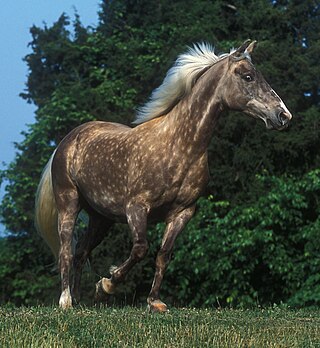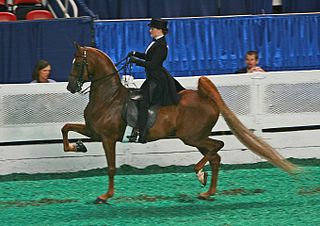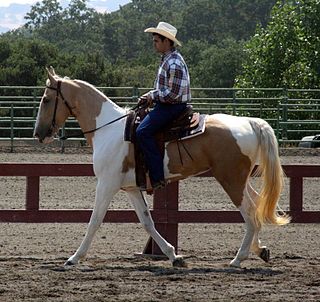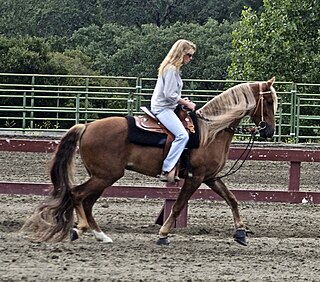
The Peruvian Horse is a breed of light saddle horse known for its smooth ride. It is distinguished by a natural, four-beat, lateral gait called the paso llano. This breed is protected by the Peruvian government through Decree number 25919 of Peru enacted on November 28, 1992, and has been declared a Cultural Heritage of the Nation by the National Institute of Culture (INC). Due to the isolation suffered for about 400 years and the selection made by their breeders, this breed is very particular in their body proportions and an ambling gait or "paso llano" that is characteristic. It is typical of the northern Peruvian regions of the country from which it originated. Trujillo city is considered the cradle of typical Peruvian Horses.

The Standardbred is an American horse breed best known for its ability in harness racing, where members of the breed compete at either a trot or pace. Developed in North America, the Standardbred is recognized worldwide, and the breed can trace its bloodlines to 18th-century England. They are solid, well-built horses with good dispositions. In addition to harness racing, the Standardbred is used for a variety of equestrian activities, including horse shows and pleasure riding, particularly in the Midwestern and Eastern United States and in Southern Ontario.

Horses can use various gaits during locomotion across solid ground, either naturally or as a result of specialized training by humans.

The Icelandic horse is a breed of horse developed in Iceland. Although the horses are small, at times pony-sized, most registries for the Icelandic refer to it as a horse. Icelandic horses are long-lived and hardy. In their native country they have few diseases; Icelandic law prevents horses from being imported into the country and exported animals are not allowed to return. In addition to the gaits of walk, trot, and canter/gallop typical of other horse breeds, many Icelandic horses can also do the tölt and the flying pace. The only breed of horse in Iceland, they are also popular internationally, and sizable populations exist in Europe and North America. The breed is still used for traditional sheepherding work in its native country, as well as for leisure, showing, and racing.

The Tennessee Walking Horse or Tennessee Walker is a breed of gaited horse known for its unique four-beat running-walk and flashy movement. It was originally developed as a riding horse on farms and plantations in the American South. It is a popular riding horse due to its calm disposition, smooth gaits and sure-footedness. The Tennessee Walking Horse is often seen in the show ring, but is also popular as a pleasure and trail riding horse using both English and Western equipment. Tennessee Walkers are also seen in movies, television, and other entertainment.

The trot is a two-beat diagonal horse gait where the diagonal pairs of legs move forward at the same time with a moment of suspension between each beat. It has a wide variation in possible speeds, but averages about 13 kilometres per hour (8.1 mph). A very slow trot is sometimes referred to as a jog. An extremely fast trot has no special name, but in harness racing, the trot of a Standardbred is faster than the gallop of the average non-racehorse, and has been clocked at over 30 miles per hour (48 km/h).

A palfrey is a type of horse that was highly valued as a riding horse in the Middle Ages. It was a lighter-weight horse, usually a smooth gaited one that could amble, suitable for riding over long distances. Palfreys were not a specific breed as horse breeds are understood today.

The Missouri Fox Trotter is a horse breed that originated in the state of Missouri in the United States. It was developed in the Ozark Mountains by settlers in the early 19th century, and quickly developed into a gaited breed appreciated for its stock horse abilities, stamina and smooth gaits. It performs an ambling gait known as the "fox trot", a four-beat broken diagonal gait in which the front foot of the diagonal pair lands before the hind, eliminating the moment of suspension and increasing smoothness. The main breed registry was begun in 1948 and as of 2012 registers almost 100,000 horses. A European registry was begun in 1992, and as of 2009 recognizes around 600 Fox Trotters living in Europe. In 2006, a smaller registry, focused on the preservation of the original, historic type, was begun in the United States. The Fox Trotter is a mid-sized, muscular breed, used mainly for trail riding and ranch work.

The Rocky Mountain Horse is a horse breed developed in the state of Kentucky in the United States. Despite its name, it originated not in the Rocky Mountains, but instead in the Appalachian Mountains. A foundation stallion, brought from the western United States to eastern Kentucky around 1890, began the Rocky Mountain type in the late 19th century. In the mid-20th century, a stallion named Old Tobe, owned by a prominent breeder, was used to develop the modern type; today most Rocky Mountain Horses trace back to this stallion. In 1986, the Rocky Mountain Horse Association was formed and by 2005 has registered over 12,000 horses. The breed is known for its preferred "chocolate" coat color and flaxen mane and tail, the result of the relatively rare silver dapple gene acting on a black coat, seen in much of the population. It also exhibits a four-beat ambling gait known as the "single-foot". Originally developed as a multi-purpose riding, driving and light draft horse, today it is used mainly for trail riding and working cattle.

Equine conformation evaluates a horse's bone structure, musculature, and its body proportions in relation to each other. Undesirable conformation can limit the ability to perform a specific task. Although there are several faults with universal disadvantages, a horse's conformation is usually judged by what its intended use may be. Thus "form to function" is one of the first set of traits considered in judging conformation. A horse with poor form for a Grand Prix show jumper could have excellent conformation for a World Champion cutting horse, or to be a champion draft horse. Every horse has good and bad points of its conformation and many horses excel even with conformation faults.

An ambling gait or amble is any of several four-beat intermediate horse gaits, all of which are faster than a walk but usually slower than a canter and always slower than a gallop. Horses that amble are sometimes referred to as "gaited", particularly in the United States. Ambling gaits are smoother for a rider than either the two-beat trot or pace and most can be sustained for relatively long periods, making them particularly desirable for trail riding and other tasks where a rider must spend long periods in the saddle. Historically, horses able to amble were highly desired for riding long distances on poor roads. Once roads improved and carriage travel became popular, their use declined in Europe but continued in popularity in the Americas, particularly in areas where plantation agriculture was practiced and the inspection of fields and crops necessitated long daily rides.

Saddle seat is a style of horse riding within the category of English riding that is designed to show off the high action of certain horse breeds. The style developed into its modern form in the United States, and is also seen in Canada and South Africa. To a much lesser extent, it is ridden with American horse breeds in Europe and Australia.
The Florida Cracker Horse is a critically endangered horse breed from the state of Florida in the United States. It is genetically and physically similar to many other Spanish-style horses, especially those from the Spanish Colonial horse group, including the Banker horse of North Carolina, and the Carolina Marsh Tacky of South Carolina.

Western riding is considered a style of horse riding which has evolved from the ranching and welfare traditions which were brought to the Americas by the Spanish Conquistadors, as well as both equipment and riding style which evolved to meet the working needs of the cowboy in the American West. At the time, American cowboys had to work long hours in the saddle and often over rough terrain, sometimes having to rope a cattle using a lariat, also known as a lasso. Because of the necessity to control the horse with one hand and use a lariat with the other, western horses were trained to neck rein, that is, to change direction with light pressure of a rein against the horse's neck. Horses were also trained to exercise a certain degree of independence in using their natural instincts to follow the movements of a cow, thus a riding style developed that emphasized a deep, secure seat, and training methods encouraged a horse to be responsive on very light rein contact.
The Racking Horse is a horse breed derived from the Tennessee Walking Horse, recognized by the USDA in 1971. It is known for a distinctive singlefoot gait. In 1971, the Racking Horse Breeders' Association of America, headquartered in Decatur, Alabama, was formed as the breed registry. Its goal is to preserve the breed in a natural state with little or no artificial devices that enhance gait. The horse's tail is naturally raised without nicking or tail sets. Some classes allow special shoes that enhance action, and a relatively newer class allows the use of chains, six ounces and under as action devices. The practice of soring, illegal under the Horse Protection Act of 1970, is also seen within the Racking Horse world. Since the breed's inception, about 80,000 Racking Horses have been registered, with the largest populations located in the US states of Alabama and Tennessee.

The Spotted Saddle Horse is a horse breed from the United States that was developed by crossing Spanish-American type gaited pinto ponies with gaited horse breeds, such as the Tennessee Walking Horse. The result was a colorful, smooth-gaited horse, used in the show ring and for pleasure and trail riding. Two registries have been created for the breed, one in 1979 and the other in 1985. The two have similar registration requirements, although one has an open stud book and the other is slightly more strict with regard to parentage requirements, having a semi-closed stud book. The Spotted Saddle Horse is a light riding horse, always pinto in color. Solid-colored foals from registered parents may be registered for identification purposes, so their pinto-colored foals have documented parentage. They always perform an ambling gait, rather than a trot, in addition to the gaits of walk and canter, performed by all breeds.

The Kentucky Mountain Saddle Horse is a horse breed from the U.S. state of Kentucky. Developed as an all-around farm and riding horse in eastern Kentucky, it is related to the Tennessee Walking Horse and other gaited breeds. In 1989 the Kentucky Mountain Saddle Horse Association (KMSHA) was formed, and in 2002, the subsidiary Spotted Mountain Horse Association (SMHA) was developed to register Kentucky Mountain Saddle Horses with excessive white markings and pinto patterns. Conformation standards are the same for the two groups of horses, with the main difference being the color requirements. The KMSHA studbook is now closed to horses from unregistered parents, although it cross-registers with several other registries, while the SMHA studbook remains open.

This is a basic glossary of equestrian terms that includes both technical terminology and jargon developed over the centuries for horses and other equidae, as well as various horse-related concepts. Where noted, some terms are used only in American English (US), only in British English (UK), or are regional to a particular part of the world, such as Australia (AU).

The Mountain Pleasure Horse is a breed of gaited horse that was developed in the Appalachian Mountains of Eastern Kentucky. This breed reflects the primitive Appalachian gaited horse type and genetic testing shows them to share ancestry with earlier breeds developed in the region, including the American Saddlebred, the Tennessee Walking Horse and the Rocky Mountain Horse. Some Mountain Pleasure Horse bloodlines are traceable for over 180 years.
















